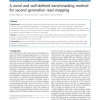116 search results - page 15 / 24 » Finding Similar Regions in Many Sequences |
BMCBI
2004
13 years 7 months ago
2004
Background: Many current gene prediction methods use only one model to represent proteincoding regions in a genome, and so are less likely to predict the location of genes that ha...
BMCBI
2011
12 years 11 months ago
2011
Background: Second generation sequencing technologies yield DNA sequence data at ultra high-throughput. Common to most biological applications is a mapping of the reads to an almo...
IMSCCS
2006
IEEE
14 years 1 months ago
2006
IEEE
Background: Hydrophobins are fungal proteins that can turn into amphipathic membranes at hydrophilic/hydrophobic interfaces by self-assembly. The assemblages by Class I hydrophobi...
BMCBI
2010
13 years 7 months ago
2010
Background: Sequence comparisons make use of a one-letter representation for amino acids, the necessary quantitative information being supplied by the substitution matrices. This ...
ECCV
2008
Springer
14 years 9 months ago
2008
Springer
This paper addresses the segmentation from an image of entities that have the form of a `network', i.e. the region in the image corresponding to the entity is composed of bran...

